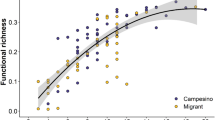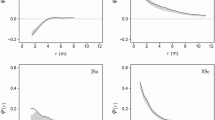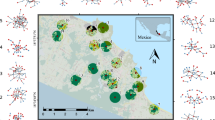Abstract
A new approach to landscape ecology involves the application of the eco-field hypothesis and the General Theory of Resources. In this study, we describe the putative eco-field of bark beetles as a spatial configuration with a specific meaning-carrier for every organism-resource interaction. Bark beetles are insects with key roles in matter and energy cycles in coniferous forests, which cause significant changes to forestry landscapes when outbreaks occur. Bark beetles are guided towards host trees by the recognition of semiotic signals using a specific eco-field. These signals mainly comprise a group of scents, which are called the odourtope. Their interactions with other organisms (fungi, bacteria, nematodes, predators, etc.) occur by sharing relevant information from the eco-field networks (representamen networks) in the forest ecosystem. The eco-field networks modulate the expansion of the realized semiotic niche of the bark beetle towards the potential semiotic niche. Moreover, the niche construction process can be initiated by interchanging signals among species living in the same place, where these signals allow the exploitation of the required resources. If different organisms are interdependent on signals in eco-field networks, then this process may result in the establishment of mutualistic relationships. This is an example of how evolutionary processes are initiated by the recognition of signals in a network of eco-fields.






Similar content being viewed by others
References
Adams, A. S., Aylward, F. O., Adams, S. M., Erbilgin, N., Aukema, B. H., Currie, C. R., Suen, G., & Raffa, K. F. (2013). Mountain pine beetles colonizing historical and naïve host trees are associated with a bacterial community highly enriched in genes contributing to terpene metabolism. Applied and Environmental Microbiology, 79(11), 3468–3475. doi:10.1128/AEM.00068-13.
Andersson, M. N. (2012). Mechanisms of odor coding in coniferous bark beetles: from neuron to behavior and application. Psyche: A Journal of Entomology, 2012, e149572. doi:10.1155/2012/149572.
Ayres, B. D., Ayres, M. P., Abrahamson, M. D., & Teale, S. A. (2001). Resource partitioning and overlap in three sympatric species of Ips bark beetles (Coleoptera: Scolytidae). Oecologia, 128(3), 443–453. doi:10.1007/s004420100665.
Barbieri, M. (2009). A short history of biosemiotics. Biosemiotics, 2(2), 221–245. doi:10.1007/s12304-009-9042-8.
Barker, G., & Odling-Smee, J. (2014). Integrating ecology and evolution: niche construction and ecological engineering. In G. Barker, E. Desjardins, & T. Pearce (Eds.), Entangled Life (pp. 187–211). Springer: Netherlands. doi:10.1007/978-94-007-7067-610.
Ben Jamaa, M. L., Lieutier, F., Yart, A., Jerraya, A., & Khouja, M. L. (2007). The virulence of phytopathogenic fungi associated with the bark beetles Tomicus piniperda and Orthotomicus erosus in Tunisia. Forest Pathology, 37(1), 51–63. doi:10.1111/j.1439-0329.2007.00478.x.
Bezos, D., Martínez-Álvarez, P., Diez, J. J., & Fernández, M. M. (2015). The pine shoot beetle Tomicus piniperda as a plausible vector of Fusarium circinatum in northern Spain. Annals of Forest Science, 72(8), 1079–1088. doi:10.1007/s13595-015-0515-4.
Boone, C. K., Six, D. L., Zheng, Y., & Raffa, K. F. (2008). Parasitoids and dipteran predators exploit volatiles from microbial symbionts to locate bark beetles. Environmental Entomology, 37(1), 150–161. doi:10.1093/ee/37.1.150.
Boone, C. K., Keefover-Ring, K., Mapes, A. C., Adams, A. S., Bohlmann, J., & Raffa, K. F. (2013). Bacteria associated with a tree-killing insect reduce concentrations of plant defense compounds. Journal of Chemical Ecology, 39(7), 1003–1006. doi:10.1007/s10886-013-0313-0.
Bordenstein, S. R., & Theis, K. R. (2015). Host biology in light of the microbiome: ten principles of holobionts and hologenomes. PLoS Biology, 13(8), e1002226. doi:10.1371/journal.pbio.1002226.
Bruni, L. E. (2011). The multitrophic Plant–Herbivore–Parasitoid–Pathogen system: a biosemiotic perspective. In C. Emmeche & K. Kull (Eds.), Towards a Semiotic Biology (pp. 143–166). London: Imperial College Press.
Byers, J. A. (2012). Bark Beetles, Pityogenes bidentatus, orienting to aggregation pheromone avoid conifer monoterpene odors when flying but not when walking. Psyche: A Journal of Entomology, 2012, e940962. doi:10.1155/2012/940962.
Byers, J. A., & Zhang, Q. (2011). Chemical ecology of bark beetles in regard to search and selection of host trees. In T. Liu & L. Kang (Eds.), Recent Advances in Entomological Research (pp. 150–190). Berlin: Springer. doi:10.1007/978-3-642-17815-3_9.
Campbell, S. A., & Borden, J. H. (2006a). Close-range, in-flight integration of olfactory and visual information by a host-seeking bark beetle. Entomologia Experimentalis et Applicata, 120(2), 91–98. doi:10.1111/j.1570-7458.2006.00425.x.
Campbell, S. A., & Borden, J. H. (2006b). Integration of visual and olfactory cues of hosts and non-hosts by three bark beetles (Coleoptera: Scolytidae). Ecological Entomology, 31(5), 437–449. doi:10.1111/j.1365-2311.2006.00809.x.
Chen, H.-F., Salcedo, C., & Sun, J.-H. (2012). Male mate choice by chemical cues leads to higher reproductive success in a bark beetle. Animal Behaviour, 83(2), 421–427. doi:10.1016/j.anbehav.2011.11.012.
Chiu, L., & Gilbert, S. F. (2015). The birth of the holobiont: multi-species birthing through mutual scaffolding and niche construction. Biosemiotics, 8(2), 191–210. doi:10.1007/s12304-015-9232-5.
Costa, A., & Reeve, J. D. (2011a). Upwind flight response of the bark beetle predator Thanasimus dubius towards olfactory and visual cues in a wind tunnel. Agricultural and Forest Entomology, 13(3), 283–290. doi:10.1111/j.1461-9563.2011.00519.x.
Costa, A., & Reeve, J. D. (2011b). Olfactory experience modifies semiochemical responses in a bark beetle predator. Journal of Chemical Ecology, 37(11), 1166–1176. doi:10.1007/s10886-011-0027-0.
Dicke, M., & Sabelis, M. W. (1988). Infochemical terminology: based on cost-benefit analysis rather than origin of compounds? Functional Ecology, 2, 131–139.
El-Hani, C. N., Arnellos, A., & Queiroza, J. (2007). Modeling a semiotic process in the immune system: signal transduction in B-cells activation. tripleC, 5(2), 24–36.
Elton, C. (1927). Animal ecology. New York: The Macmillian Company.
Faccoli, M., Anfora, G., & Tasin, M. (2008). Responses of the Mediterranean pine shoot beetle Tomicus destruens (Wollaston) to pine shoot and bark volatiles. Journal of Chemical Ecology, 34(9), 1162–1169. doi:10.1007/s10886-008-9503-6.
Farina, A. (2008). The landscape as a semiotic interface between organisms and resources. Biosemiotics, 1(1), 75–83. doi:10.1007/s12304-008-9006-4.
Farina, A. (2010). The Cognitive Landscape. In S. R. Todd, T. J. Hawbaker, & J. P. Metzger (Eds.), Ecology, cognition and landscape: linking natural and social systems (Vol. 11) (pp. 103–138). Dordrecht: Springer Science & Business Media.
Farina, A. (2012). A biosemiotic perspective of the resource criterion: toward a General Theory of Resources. Biosemiotics, 5(1), 17–32. doi:10.1007/s12304-008-9006-4.
Farina, A. (2014). Soundscape and landscape ecology. In Soundscape Ecology. Principles, Patterns, Methods and Applications (pp. 1–28). Dordrecht: Springer. doi:10.1007/978-94-007-7374-5.
Farina, A., & Belgrano, A. (2004). The eco-field: a new paradigm for landscape ecology. Ecological Research, 19(1), 107–110. doi:10.1111/j.1440-1703.2003.00613.x.
Farina, A., & Belgrano, A. (2006). The eco-field hypothesis: toward a cognitive landscape. Landscape Ecology, 21(1), 5–17. doi:10.1007/s10980-005-7755-x.
Farina, A., & Napoletano, B. (2010). Rethinking the landscape: new theoretical perspectives for a powerful agency. Biosemiotics, 3(2), 177–187. doi:10.1007/s12304-010-9086-9.
Farina, A., & Pieretti, N. (2013). From umwelt to soundtope: an epistemological essay on cognitive ecology. Biosemiotics, 7(1), 1–10. doi:10.1007/s12304-013-9191-7.
Farina, A., & Pieretti, N. (2014). Acoustic codes in action in a soundscape context. Biosemiotics, 7(2), 321–328. doi:10.1007/s12304-014-9213-0.
Farina, A., Santolini, R., Pagliaro, G., Scozzafava, S., & Schipani, I. (2005). Eco-semiotics: A new field of competence for ecology to overcome the frontier between environmental complexity and human culture in the Mediterranean. Israel Journal of Plant Sciences, 53(3-4), 167–175. doi:10.1560/5UTK-YW53-KDQT-YU48.
Farina, A., Lattanzi, E., Malavasi, R., Pieretti, N., & Piccioli, L. (2011). Avian soundscapes and cognitive landscapes: theory, application and ecological perspectives. Landscape Ecology, 26(9), 1257–1267. doi:10.1007/s10980-011-9617-z.
Farina, A., Pieretti, N., & Malavasi, R. (2014). Patterns and dynamics of (bird) soundscapes: A biosemiotic interpretation. Semiotica, 2014(198), 241–255. doi:10.1515/sem-2013-0109.
Favareau, D. (2009). Concepts of molecular biosemiotics. In M. Barbieri & J. Hoffmeyer (Eds.), Essential Readings in Biosemiotics (3rd ed., pp. 463–500). Netherlands: Springer. doi:10.1007/978-1-4020-9650-1_15.
Filotas, E., Parrott, L., Burton, P. J., Chazdon, R. L., Coates, K. D., Coll, L., Haeussier, S., Martin, K., Nocentini, S., Puettmann, K. J., Putz, F. E., Simard, S. W., & Messier, C. (2014). Viewing forests through the lens of complex systems science. Ecosphere, 5(1), 1–23. doi:10.1890/ES13-00182.1.
Fleming, A. J., Lindeman, A. A., Carroll, A. L., & Yack, J. E. (2013). Acoustics of the mountain pine beetle (Dendroctonus ponderosae) (Curculionidae, Scolytinae): sonic, ultrasonic, and vibration characteristics. Canadian Journal of Zoology, 91(4), 235–244. doi:10.1139/cjz-2012-0239.
Florkin, M. (1974). Concepts of molecular biosemiotics and molecular evolution. In A. M. Florkin & E. H. Stotz (Eds.), Comprehensive Biochemistry (29th ed., pp. 1–124). Amsterdam: Elsevier.
Gallego, D., Cánovas, F., Esteve, M. A., & Galián, J. (2004). Descriptive biogeography of Tomicus (Coleoptera: Scolytidae) species in Spain. Journal of Biogeography, 31(12), 2011–2024. doi:10.1111/j.1365-2699.2004.01131.x.
Gallego, D., Galián, J., Diez, J. J., & Pajares, J. A. (2008). Kairomonal responses of Tomicus destruens (Col., Scolytidae) to host volatiles α-pinene and ethanol. Journal of Applied Entomology, 132(8), 654–662. doi:10.1111/j.1439-0418.2008.01304.x.
Gitau, C. W., Bashford, R., Carnegie, A. J., & Gurr, G. M. (2013). A review of semiochemicals associated with bark beetle (Coleoptera: Curculionidae: Scolytinae) pests of coniferous trees: A focus on beetle interactions with other pests and their associates. Forest Ecology and Management, 297, 1–14. doi:10.1016/j.foreco.2013.02.019.
Goodsman, D. W., Erbilgin, N., & Lieffers, V. J. (2012). The Impact of phloem nutrients on overwintering mountain pine beetles and their fungal symbionts. Environmental Entomology, 41(3), 478–486. doi:10.1603/EN11205.
Grinnell, J. (1924). Geography and evolution. Ecology, 5(3), 225–229. doi:10.2307/1929447.
Guerrero, A., Feixas, J., Pajares, J., Wadhams, L. J., Pickett, J. A., & Woodcock, C. M. (1997). Semiochemically induced inhibition of behaviour of Tomicus destruens (Woll.) (Coleoptera: Scolytidae). Naturwissenschaften, 84(4), 155–157. doi:10.1007/s001140050369.
Hoffmeyer, J. (2008). The semiotic niche. Journal of Mediterranean Ecology, 9, 5–30.
Hofstetter, R. W., & Moser, J. C. (2014). The role of mites in insect-fungus associations. Annual Review of Entomology, 59(1), 537–557. doi:10.1146/annurev-ento-011613-162039.
Hutchinson, G. E. (1957). The multivariate niche. Cold Spring Harbor Symposium on Quantitative Biology, 22, 415–421.
Kelsey, R. G., Gallego, D., Sánchez-García, F. J., & Pajares, J. A. (2014). Ethanol accumulation during severe drought may signal tree vulnerability to detection and attack by bark beetles. Canadian Journal of Forest Research, 44(6), 554–561. doi:10.1139/cjfr-2013-0428.
Kerdelhué, C., Roux-Morabito, G., Forichon, J., Chambon, J.-M., Robert, A., & Lieutier, F. (2002). Population genetic structure of Tomicus piniperda L. (Coleoptera: Scolytidae) and validation of T. destruens (Woll.). Molecular Ecology, 11(3), 483–494.
Kolosova, N., & Bohlmann, J. (2012). Conifer defense against insects and fungal pathogens. In R. Matyssek, H. Schnyder, W. Oßwald, D. Ernst, J. C. Munch, & H. Pretzsch (Eds.), Growth and Defence in Plants (pp. 85–109). Berlin: Springer. doi:10.1007/978-3-642-30645-7_4.
Kull, K. (2010). Ecosystems are made of semiosic bonds: consortia, umwelten, biophony and ecological codes. Biosemiotics, 3(3), 347–357. doi:10.1007/s12304-010-9081-1.
Laland, K., Uller, T., Feldman, M., Sterelny, K., Müller, G. B., Moczek, A., Jablonka, E., Odling-Smee, J., Wray, G. A., Hoekstra, H. E., Futuyma, D. J., Lenski, R. E., Mackay, T. F. C., Schluter, D., & Strassmann, J. E. (2014). Does evolutionary theory need a rethink? Nature, 514(7521), 161–164. doi:10.1038/514161a.
Laland, K. N., Uller, T., Feldman, M. W., Sterelny, K., Müller, G. B., Moczek, A., Jablonka, E., & Odling-Smee, J. (2015). The extended evolutionary synthesis: its structure, assumptions and predictions. Proceedings of the Royal Society B, 282(1813), 20151019. doi:10.1098/rspb.2015.1019.
Lindeman, A. A., & Yack, J. E. (2015). What is the password? Female bark beetles (Scolytinae) grant males access to their galleries based on courtship song. Behavioural Processes, 115, 123–131. doi:10.1016/j.beproc.2015.03.009.
Lu, M., Miller, D. R., & Sun, J.-H. (2007). Cross-attraction between an exotic and a native pine bark beetle: a novel invasion mechanism? PLoS ONE, 2(12), e1302. doi:10.1371/journal.pone.0001302.
Lu, M., Wingfield, M. J., Gillette, N. E., Mori, S. R., & Sun, J.-H. (2010). Complex interactions among host pines and fungi vectored by an invasive bark beetle. New Phytologist, 187(3), 859–866. doi:10.1111/j.1469-8137.2010.03316.x.
Lu, R. C., Wang, H. B., Zhang, Z., Byers, J. A., Jin, Y. J., Wen, H. F., & Shi, W. J. (2012). Coexistence and competition between Tomicus yunnanensis and T. minor (Coleoptera: Scolytinae) in Yunnan Pine. Psyche: A Journal of Entomology, 2012, e185312. doi:10.1155/2012/185312.
Machingambi, N. M., Roux, J., Dreyer, L. L., & Roets, F. (2014). Bark and ambrosia beetles (Curculionidae: Scolytinae), their phoretic mites (Acari) and associated Geosmithia species (Ascomycota: Hypocreales) from Virgilia trees in South Africa. Fungal Biology, 118(5), 472–483. doi:10.1016/j.funbio.2014.03.006.
Malavasi, R., Kull, K., & Farina, A. (2014). The acoustic codes: how animal sign processes create sound-topes and consortia via conflict avoidance. Biosemiotics, 7(1), 89–95. doi:10.1007/s12304-013-9177-5.
Maran, T. (2012). Are ecological codes archetypal structures? In T. Maran, K. Lindström, R. Magnus, & M. Tønnessen (Eds.), Semiotics in the Wild. Essays in Honour of Kalevi Kull on the Occasion of His 60th Birthday (pp. 147–156). Tartu: Tartu University Press.
Maran, T., & Kull, K. (2014). Ecosemiotics: main principles and current developments. Geografiska Annaler: Series B, Human Geography, 96(1), 41–50. doi:10.1111/geob.12035.
Matthews, B., De Meester, L., Jones, C. G., Ibelings, B. W., Bouma, T. J., Nuutinen, V., van de Koppel, J., & Odling-Smee, J. (2014). Under niche construction: an operational bridge between ecology, evolution, and ecosystem science. Ecological Monographs, 84(2), 245–263. doi:10.1890/13-0953.1.
Miller, D. R., Gibson, K. E., Raffa, K. F., Seybold, S. J., Teale, S. A., & Wood, D. L. (1997). Geographic variation in response of pine engraver, Ips pini, and associated species to pheromone, lanierone. Journal of Chemical Ecology, 23(8), 2013–2031. doi:10.1023/B:JOEC.0000006486.39056.48.
Nielsen, S. N. (2007). Towards an ecosystem semiotics: some basic aspects for a new research programme. Ecological Complexity, 4(3), 93–101. doi:10.1016/j.ecocom.2007.04.001.
Nöth, W., & Kull, K. (2001). Introduction: special issue on semiotics of nature. Σημειωτκή - Sign Systems Studies, 1, 9–11.
Odling-Smee, F. J., Laland, K. N., & Feldman, M. W. (2003). Niche Construction, The Neglected Process in Evolution (MPB-37). Princeton: Princeton University Press.
Pasteels, J. M. (1982). Is kairomone a valid and useful term? Journal of Chemical Ecology, 8(7), 1079–1081.
Patten, B. C. (1978). Systems approach to the concept of environment. The Ohio Journal of Science., 78(4), 206–222.
Pérez, L., Dragićević, S., & White, R. (2013). Model testing and assessment: perspectives from a swarm intelligence, agent-based model of forest insect infestations. Computers, Environment and Urban Systems, 39, 121–135. doi:10.1016/j.compenvurbsys.2012.10.004.
Peterson, A. T., Soberón, J., Pearson, R. G., Anderson, R. P., Martínez-Meyer, E., Nakamura, M., & Araújo, M. B. (2011). Ecological Niches and Geographic Distributions (MPB-49). Princeton: Princeton University Press.
Peverieri, G. S., Capretti, P., & Tiberi, R. (2006). Associations between Tomicus destruens and Leptographium spp. in Pinus pinea and P. pinaster stands in Tuscany, central Italy. Forest Pathology, 36(1), 14–20. doi:10.1111/j.1439-0329.2006.00427.x.
Pizzolotto, R. (2009). Characterization of different habitats on the basis of the species traits and eco-field approach. Acta Oecologica, 35(1), 142–148. doi:10.1016/j.actao.2008.09.004.
Pulliam, H. R. (2000). On the relationship between niche and distribution. Ecology Letters, 3(4), 349–361. doi:10.1046/j.1461-0248.2000.00143.x.
Raffa, K. F., Hobson, K. R., LaFontaine, S., & Aukema, B. H. (2007). Can chemical communication be cryptic? Adaptations by herbivores to natural enemies exploiting prey semiochemistry. Oecologia, 153(4), 1009–1019. doi:10.1007/s00442-007-0786-z.
Reeve, J. D., Strom, B. L., Rieske, L. K., Ayres, B. D., & Costa, A. (2009). Geographic variation in prey preference in bark beetle predators. Ecological Entomology, 34(2), 183–192. doi:10.1111/j.1365-2311.2008.01055.x.
Romón, P., Iturrondobeitia, J. C., Gibson, K., Lindgren, B. S., & Goldarazena, A. (2007). Quantitative association of bark beetles with pitch canker fungus and effects of verbenone on their semiochemical communication in monterey pine forests in northern Spain. Environmental Entomology, 36(4), 743–750. doi:10.1093/ee/36.4.743.
Sabbatini-Peverieri, G., Faggi, M., Marziali, L., Panzavolta, T., Bonuomo, L., & Tiberi, R. (2004). Use of attractant and repellent substances to control Tomicus destruens (Coleoptera: Scolytidae) in Pinus pinea and P. pinaster pine forests of Tuscany. Entomologica, 38, 91–102.
Sebeok, T. A. (2001). Biosemiotics: its roots, proliferation, and prospects. Semiotica, 2001(134), 61–78. doi:10.1515/semi.2001.014.
Seybold, S. J., Huber, D. P. W., Lee, J. C., Graves, A. D., & Bohlmann, J. (2006). Pine monoterpenes and pine bark beetles: a marriage of convenience for defense and chemical communication. Phytochemistry Reviews, 5(1), 143–178. doi:10.1007/s11101-006-9002-8.
Silva, X., Terhonen, E., Sun, H., Kasanen, R., Heliövaara, K., Jalkanen, R., & Asiegbu, F. O. (2015). Comparative analyses of fungal biota carried by the pine shoot beetle (Tomicus piniperda L.) in northern and southern Finland. Scandinavian Journal of Forest Research, 30(6), 497–506. doi:10.1080/02827581.2015.1031824.
Six, D. L. (2012). Ecological and evolutionary determinants of bark beetle —fungus symbioses. Insects, 3(1), 339–366. doi:10.3390/insects3010339.
Six, D. L. (2013). The bark beetle holobiont: why microbes matter. Journal of Chemical Ecology, 39(7), 989–1002. doi:10.1007/s10886-013-0318-8.
Sorberón, J., & Peterson, A. T. (2005). Interpretation of models of fundamental ecological niches and species’ distributional areas. Biodiversity Informatics, 2, 1–10. doi:10.17161/bi.v2i0.4.
Sõukand, R., & Kalle, R. (2010). Plant as object within herbal landscape: different kinds of perception. Biosemiotics, 3(3), 299–313. doi:10.1007/s12304-010-9078-9.
Strom, B. L., & Goyer, R. A. (2001). Effect of silhouette color on trap catches of Dendroctonus frontalis (Coleoptera: Scolytidae). Annals of the Entomological Society of America, 94(6), 948–953.
Sun, J., Lu, M., Gillette, N. E., & Wingfield, M. J. (2013). Red turpentine beetle: innocuous native becomes invasive tree killer in China. Annual Review of Entomology, 58(1), 293–311. doi:10.1146/annurev-ento-120811-153624.
Susoy, V., & Herrmann, M. (2014). Preferential host switching and codivergence shaped radiation of bark beetle symbionts, nematodes of Micoletzkya (Nematoda: Diplogastridae). Journal of Evolutionary Biology, 27(5), 889–898. doi:10.1111/jeb.12367.
Uexküll, J. (1926). Theoretical Biology. New York: Harcourt, Brace & Co.
Vasechko, G. I. (1978). Host selection by some bark beetles (Col., Scolytidae). Zeitschrift für Angewandte Entomologie, 85(1-4), 141–153.
Vega, F. E., & Hofstetter, R. W. (2014). Bark Beetles: Biology and Ecology of Native and Invasive Species. Academic Press.
Xiaoyi, W., & Zhongqi, Y. (2008). Behavioral mechanisms of parasitic wasps for searching concealed insect hosts. Acta Ecologica Sinica, 28(3), 1257–1269. doi:10.1016/S1872-2032(08)60039-6.
Xu, L., Lou, Q., Cheng, C., Lu, M., & Sun, J. (2015). Gut-associated bacteria of Dendroctonus valens and their Involvement in verbenone production. Microbial Ecology, 70(4), 1012–1023. doi:10.1007/s00248-015-0625-4.
Yang, L. H., & Gratton, C. (2014). Insects as drivers of ecosystem processes. Current Opinion in Insect Science, 2, 26–32. doi:10.1016/j.cois.2014.06.004.
Acknowledgements
This study was supported by Projects 12023/PI/09 and 19908/GERM/15 from the Fundación Séneca of the Region of Murcia government. The authors thank A. López-López, International Science Editing and anonymous referee for critically reading and improving the manuscript.
Author information
Authors and Affiliations
Corresponding author
Rights and permissions
About this article
Cite this article
Sánchez-García, F.J., Machado, V., Galián, J. et al. Application of the Eco-field and General Theory of Resources to Bark Beetles: Beyond the Niche Construction Theory. Biosemiotics 10, 57–73 (2017). https://doi.org/10.1007/s12304-016-9283-2
Received:
Accepted:
Published:
Issue Date:
DOI: https://doi.org/10.1007/s12304-016-9283-2




